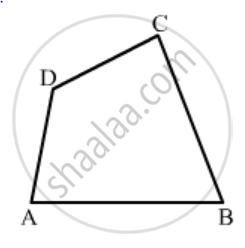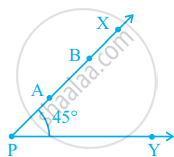Advertisements
Advertisements
प्रश्न
In Fig. 16.19, ABCD is a quadrilateral.
Name a pair of adjacent angles.

उत्तर
\[ \text{ (∠A, ∠B) or (∠B, ∠C) or (∠C, ∠D) or (∠D, ∠A) } \]
APPEARS IN
संबंधित प्रश्न
How many diagonals does following have?
A regular hexagon
ABCD is a parallelogram, AD is produced to E so that DE = DC and EC produced meets AB produced in F. Prove that BF = BC.
Complete the following statement by means of one of those given in brackets against each:
If in a quadrilateral only one pair of opposite sides are parallel, the quadrilateral is ................
Use the following figure to find the value of x

In quadrilateral WXYZ, the pairs of opposite angles are ______.
In figure, if point A is shifted to point B along the ray PX such that PB = 2PA, then the measure of ∠BPY is ______.
A pair of opposite sides of a trapezium are ______.
Using the information given, name the right angles in part of figure:
AC ⊥ CD
Draw a rough sketch of a quadrilateral KLMN. State two pairs of adjacent angles.
Investigate :
Use strips and fasteners to make a triangle and a quadrilateral.
Try to push inward at any one vertex of the triangle. Do the same to the quadrilateral. Is the triangle distorted? Is the quadrilateral distorted? Is the triangle rigid?
Why is it that structures like electric towers make use of triangular shapes and not quadrilaterals?
